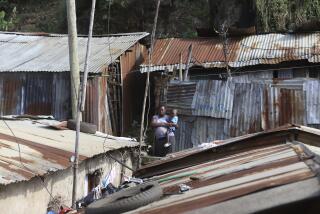Reality Falls Far Short of South African Government’s Hopes for Housing
- Share via
JOHANNESBURG, South Africa — President Nelson Mandela took office with high hopes for housing citizens like 4-month-old Vanessa Ndlovu, who was born in a cardboard hovel in the shadows of Johannesburg’s skyscrapers.
Now it seems the best that can be built for Vanessa and her parents is a better shack, perhaps one with running water or a toilet out back.
Humbled by its own inexperience and by the size and complexity of the problems it inherited from South Africa’s apartheid era, Mandela’s government has had to admit it can do little to help the helpless.
“If you don’t have sufficient resources, and if your own private sector is reluctant to do anything, then you’ll end up using government money--and government money alone can’t build houses,” said Dan Mofokeng, housing minister for Gauteng, the province that includes the industrial hub of Johannesburg.
With most of South Africa’s 40 million people poor and more than one-third of the work force unemployed, commercial lenders are leery of the home-mortgage business, leaving the problem to the government.
The governing African National Congress estimates it needs to build homes for 350,000 households every year over the next decade to erase the existing need and make sure a new waiting list doesn’t appear.
A third of those homes are needed in Gauteng, where a constant stream of job-seekers has created a landscape of squatter camps.
Vanessa’s parents came from rural KwaZulu-Natal province four years ago in search of jobs after the brickyard that employed her father, Sipho Ndlovu, went out of business.
Neither Ndlovu nor his wife, Cynthia, finished high school. The only work they have found is collecting scrap paper and discarded soda cans to sell to recyclers. They’ve salvaged their home from trash heaps, erecting walls of cardboard and a roof of black plastic sheeting.
“This is not a house; it’s a toilet,” Cynthia Ndlovu said, pointing to her one-room shack no more than four strides across. Her daughter, wrapped tightly against her mother’s back in a blue and white polka dot blanket, cried weakly.
A man from the shack next door was doing his laundry--rinsing trousers in a basin of water drawn from a broken underground pipe, then hanging them on a line to flap in the wind and dust.
Two years ago, the Ndlovus fled their first big city home, an army barracks converted into a homeless shelter, because of overcrowding and crime.
Ndlovu said his hopes for a better future fade a little every day he picks his way to his shack past mounds of garbage and his neighbors’ smoldering cooking fires. A fire got out of hand recently, destroying 14 other shacks and blackening the Ndlovus’ walls.
“If I could get a nice place to stay, maybe my life would change,” Ndlovu said.
Camps similar to the Ndlovus’ have been moved--shacks and all--to tracts of land that mock the suburban dream. There are no houses, but plots are drawn out along Levittown-like grids, each connected to water and sewer service.
It’s a temporary solution, the country’s new black leaders say. Critics accuse the government of borrowing a page from the “site-and-service” policies of the old white minority governments, which laid out similar sites but left impoverished blacks to provide their own housing.
The ANC, which won the country’s first all-race elections in 1994, had campaigned on promises of building 1 million houses for the long neglected black majority during its five-year term.
“It may not be in the first five years. It may be in the second term or the third term,” said Mofokeng, the provincial housing minister. “We won’t be shy to say, ‘Well, we may not have built the 1 million houses, but this is what we have managed to do. Give us time.’ ”
Some progress has been made. Nationally, since 1994, the government has handed out more than 50,000 grants to subsidize new homes. But it can be months before a grant is transformed into a concrete-and-brick home, so only a few thousand subsidized houses have been built.
Mary Tomlinson, who keeps tabs on the government’s housing policy for the independent Center for Policy Studies, said most of the grants were for 15,000 rand, or about $3,300. That is the amount offered to the poorest South African families, those earning less than 800 rand ($180) a month.
With only 15,000 rand, families often cannot immediately afford to build more than a shack once they have bought their plot.
Nearly 40% of South Africans earn less than 800 rand a month, and an additional 30% earn between 800 and 1,500 rand.
Add to that an unemployment rate estimated as high as 40%, and it is easy to see why lenders are reluctant to help South Africans become homeowners.
*
Government experts say the entire economy has to be reformed before the housing problem can be solved. In its policy document, the national housing department calls for a faster-growing economy, more equitably distributed wealth, lower inflation, more jobs and a higher savings rate.
Mofokeng says the new government has spent much of its first two years streamlining a housing administration once established along racial lines and learning how to manage and evaluate grandiose proposals. It is only now beginning to reassess--and rein in--its basic assumptions.
Initial visions of a home with a yard for every family are giving way to blueprints for duplexes and low-rise apartment buildings that can be built quickly and cheaply.
Mofokeng has even suggested that people could be housed faster if more emphasis were put on building rental homes. That raises the nightmarish specter of U.S.-style inner-city projects, but South Africans may find that more palatable than the Latin American-style slums overtaking cities like Johannesburg.
More to Read
Sign up for Essential California
The most important California stories and recommendations in your inbox every morning.
You may occasionally receive promotional content from the Los Angeles Times.













